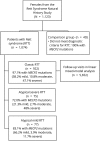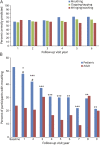Hand stereotypies: Lessons from the Rett Syndrome Natural History Study
- PMID: 31053667
- PMCID: PMC6556084
- DOI: 10.1212/WNL.0000000000007560
Hand stereotypies: Lessons from the Rett Syndrome Natural History Study
Abstract
Objective: To characterize hand stereotypies (HS) in a large cohort of participants with Rett syndrome (RTT).
Methods: Data from 1,123 girls and women enrolled in the RTT Natural History Study were gathered. Standard tests for continuous and categorical variables were used at baseline. For longitudinal data, we used repeated-measures linear and logistic regression models and nonparametric tests.
Results: HS were reported in 922 participants with classic RTT (100%), 73 with atypical severe RTT (97.3%), 74 with atypical mild RTT (96.1%), and 17 females with MECP2 mutations without RTT (34.7%). Individuals with RTT who had classic presentation or severe MECP2 mutations had higher frequency and earlier onset of HS. Heterogeneity of HS types was confirmed, but variety decreased over time. At baseline, almost half of the participants with RTT had hand mouthing, which like clapping/tapping, decreased over time. These 2 HS types were more frequently reported than wringing/washing. Increased HS severity (prevalence and frequency) was associated with worsened measures of hand function. Number and type of HS were not related to hand function. Overall clinical severity was worse with decreased hand function but only weakly related to any HS characteristic. While hand function decreased over time, prevalence and frequency of HS remained relatively unchanged and high.
Conclusions: Nearly all individuals with RTT have severe and multiple types of HS, with mouthing and clapping/tapping decreasing over time. Interaction between HS frequency and hand function is complex. Understanding the natural history of HS in RTT could assist in clinical care and evaluation of new interventions.
© 2019 American Academy of Neurology.
Figures




Comment in
-
Hand Stereotypies in Rett Syndrome.Pediatr Neurol Briefs. 2020 Feb 12;34:2. doi: 10.15844/pedneurbriefs-34-2. Pediatr Neurol Briefs. 2020. PMID: 32109978 Free PMC article.
References
-
- Hagberg B, Aicardi J, Dias K, Ramos O. A progressive syndrome of autism, dementia, ataxia, and loss of purposeful hand use in girls: Rett's syndrome: report of 35 cases. Ann Neurol 1983;14:471–479. - PubMed
-
- Rett A. On a unusual brain atrophy syndrome in hyperammonemia in childhood. Wien Med Wochensschr 1966;116:723–726. - PubMed
-
- Lee JYL, Leonard H, Piek JP, Downs J. Early development and regression in Rett syndrome. Clin Genet 2013;84:572–576. - PubMed
-
- Christodoulou J, Weaving LS. MECP2 and beyond: phenotype-genotype correlations in Rett syndrome. J Child Neurol 2003;18:669–674. - PubMed
Publication types
MeSH terms
Substances
Grants and funding
LinkOut - more resources
Full Text Sources
Medical
